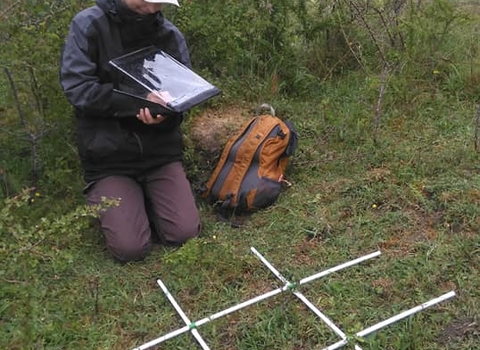COP26
COP26 is the United Nations Conference of the Parties (COP) on climate change, now in its 26th year. The first COP meeting (United Nations Framework Convention on Climate Change) was held in Berlin in March, 1995
COP26 in Glasgow (31 October-12 November) will bring together more than 190 world leaders and tens of thousands of representatives to find solutions to the worsening crisis: countries will set out plans to reduce emissions and attempt to limit global warming to 1.5 degrees Celsius. With the effects of current warming becoming increasingly evident, from record temperatures and wildfires to an increased episodes of heavy rainfall and flooding, climate change threatens people and wildlife.
Useful links:
Carbon dioxide
(invisible and colourless - probably just as well . . . )
Carbon dioxide (CO2) is one of the seven major greenhouse gases that contribute to climate change; natural sources include volcanoes, hot springs and geysers. The carbon cycle plays a key role in regulating Earth's global temperature and climate by controlling the amount of carbon dioxide in the atmosphere.
Emitted in Earth's atmosphere as a bi-product from many different, mainly industrial sources, it's the most significant long-lived greenhouse gas in our atmosphere: emissions since the Industrial Revolution - primarily from use of fossil fuels and deforestation - have rapidly increased its concentration in the atmosphere, leading to global warming and climate crisis.
Carbon footprint
(no, not a barefoot impression in the sand)
Shorthand for someone's impact on the planet: almost everything we do releases greenhouse gases into the atmosphere, from how we travel and heat homes, to the type of shampoo we use. The result of all these actions combined is your carbon footprint, measured in tonnes of carbon dioxide equivalent.
Carbon footprint is the total amount of carbon we collectively emit due to all human activities - the total amount of greenhouse gases produced to directly and indirectly support human activities. In other words: driving a car, the engine burns fuel which creates CO2, depending on its fuel consumption and distance driven. Heating a house with oil, gas or coal generates CO2; electricity and the generation of the electrical power emits CO2. Buying food and goods: the production of the food and goods emits quantities of CO2.
A carbon footprint can be calculated or estimated for an individual, an organisation, or an entire nation. The climate change impact resulting from each activity is estimated by calculating the carbon footprint, which includes not just carbon dioxide but also methane and nitrous oxide.
Useful links:
- Carbon Footprint website
- Wired - reduce your carbon footprint
- Time for Change - what is a carbon footprint?
- WWF - How big is your carbon footprint?
- Pawprint - the average UK carbon footprint
- Good Housekeeping - what is a carbon footprint?
Carbon offsetting
(ways to make carbon look good . . .)
The process of reducing or avoiding greenhouse gas emissions or removing carbon dioxide from the atmosphere to make up for emissions elsewhere. Carbon offsetting is a way to compensate for carbon footprint by funding carbon reduction projects in other parts of the world. So, for every tonne of CO2 produced by your lifestyle, you can fund offset projects to reduce the amount of CO2 in the atmosphere by a tonne. Common carbon reduction projects include protecting forests, developing clean energy sources or more efficient energy products. When every possible action has been taken to reduce a carbon footprint, individuals and organisations can offset their remaining emissions to become 'carbon neutral'. There are several accredited schemes for offsetting emissions.
Useful links:
Net Zero
(no goals scored)
The achievement of balancing emissions of carbon dioxide to reach carbon neutrality. This means reducing or removing equivalent carbon from the atmosphere to that which is emitted. In June 2019 the UK government committed to a target of Net Zero emissions by 2050, which means reducing the UK's emissions by 100% from 1990 levels. There will always be emissions that can't be reduced - to reach Net Zero, these unavoidable emissions must be matched by removing emissions in the atmosphere by the equivalent amount.
Useful links:
Carbon sink
(you can't wash your hands in this)
Any natural place that absorbs more carbon than they release - soil, forests, peatlands and oceans taking carbon out of the atmosphere.
Useful links:
Nature-based solutions
(does what it says on the tin)
The use of nature for tackling socio-environmental challenges. Alternative, non-traditional approaches to environmental issues, such as flooding, water scarcity or soil erosion via a wide variety of natural solutions, such as tree planting, peatland restoration and coastal salt marshes. Potentially game-changers for wildlife conservation typically result in thriving ecosystems which store more carbon and help meet carbon-reduction targets while providing homes for a greater diversity of plants and animals. They can also help reduce flood risk or provide much-needed shade as temperatures rise.
Two examples of our work locally
Water Works project at the Great Fen - carbon capture, peatland restoration and pioneering paludiculture
Banking on Butterflies mitigating impacts of climate change for temperature sensitive butterflies in Bedfordshire
Useful links:
- 'Let Nature Help. Climate action needs nature. Nature needs climate action. Neither will succeed if we don’t prepare for a changing world' - The Wildlife Trusts' nature-based solutions report for COP26
- IUCN - nature-based solutions
- British Ecological Society - what are nature-based solutions?
Keeping a small, nifty carbon footprint
Tips and ideas for effecting change



